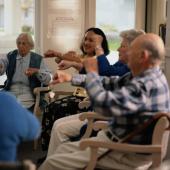
FRIDAY, June 7 (HealthDay News) — Day care centers for people with Alzheimer’s disease can give their spouses and other family caregivers a much needed source of stress relief, a new study suggests.
Such centers offer people with dementia a chance to socialize and take part in activities that stimulate their minds. The programs can also give spouses, children and other caregivers a break.
Intuitively, that should ease some of caregivers’ daily stress. But there hasn’t been much research to prove it.
In the new study, published recently in the journal Gerontologist, researchers measured stress levels of 173 family caregivers in four U.S. states who used care centers for their relative with dementia.
Through phone interviews over one week, they found caregivers were less stressed and had fewer bouts of anger on day care days than other days. And when stressors did crop up — such as problems at work — they took less of an emotional toll.
“I think this reinforces the fact that caregivers can’t do this all on their own,” said Carol Steinberg, president of the Alzheimer’s Foundation of America. “People need relief.”
Study author Steven Zarit agreed. “There’s a famous book [on caregiving] called ‘The 36-Hour Day,’ and I think that perfectly describes it,” he said. “Caregivers need help. When they get a break, it’s a way to restore.”
Allan Vann, whose wife, Clare, has Alzheimer’s, said he initially thought he could care for her on his own. A retired principal from Commack, N.Y., Vann said he was used to daily stress, and figured he had the “broad shoulders” that could bear the work of caring for his wife.
Clare Vann was diagnosed with Alzheimer’s in 2009 at age 63 — which is considered early-onset Alzheimer’s. It took three years to get that diagnosis, however. Her husband had begun noticing symptoms three years earlier, when she was talking about their two grandchildren — even though they had four — and about a trip to France, even though they’d never been there.
These days, Clare needs help with everyday basics, such as hygiene and dressing. And she also attends adult care services most days of the week.
“I don’t think I could live without that respite,” Allan said.
It gives him time to take care of daily errands and chores — and for some personal pleasures, such as reading and writing, he said. Journal writing, in particular, has offered a way to “vent.”
Many caregivers don’t know about adult day care because doctors don’t tell them, said Zarit, who is head of human development and family studies at Penn State University. “We need to do a better job of getting the message out so that people can benefit,” he said.
Also, adult care centers are not available in all areas — especially rural areas, Steinberg noted — and families typically have to foot the bill. In the United States, adult care centers charge about $70 a day, on average.
There are other types of “respite services,” such as home health aides, but finances are still an obstacle. Home-based help is even more expensive, Zarit said. Caregivers may also be able to find local groups that send a volunteer to their home to give them a needed break — though that typically amounts to a few hours of help a week, or every other week.
Vann has also found help through a caregiver support group designed specifically for spouses, offered by the Long Island Alzheimer’s Foundation. “My advice is, get yourself into a good support group,” he said. It’s helpful not only because the other group members know what you’re going through, Vann noted, but because they can also share practical advice.
As for finances, Vann has been relatively lucky in that he and his wife had taken out long-term care insurance, which helps cover the costs of services such as home care, respite care and nursing homes. Medicare, the government-funded health insurance program for older Americans, does not usually cover long-term care.
And that’s a huge problem for families, said Steinberg. “We’re really pressing for financial relief for them,” she said.
Alzheimer’s disease is the most common form of dementia, and experts predict that with the aging Baby Boomer generation, the number of Americans with Alzheimer’s could triple by 2050, to nearly 14 million.
That would substantially add to an already hefty economic toll of the disease. A recent study found that in 2010, the average cost of caring for a dementia patient was as high as $56,000. Most of that money went to long-term care, and families bore a large share of the burden.
More information
The Alzheimer’s Foundation of America has resources for caregivers.

